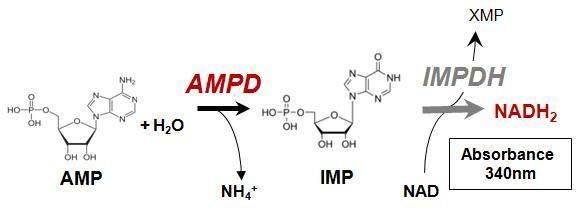Entrez 270 | Ensembl ENSG00000116748 | |
 | ||
External IDs MGI: 88015 HomoloGene: 20 GeneCards: AMPD1 | ||
Amp deaminase and the purine nucleotide cycle in hd amp deaminase deficiency symptoms mp4
AMP deaminase 1 is an enzyme that in humans is encoded by the AMPD1 gene.
Contents
- Amp deaminase and the purine nucleotide cycle in hd amp deaminase deficiency symptoms mp4
- Function
- Regulation
- Pathology
- References
Adenosine monophosphate deaminase is an enzyme that converts adenosine monophosphate (AMP) to inosine monophosphate (IMP), freeing an ammonia molecule in the process.
Function
Adenosine monophosphate deaminase 1 catalyzes the deamination of AMP to IMP in skeletal muscle and plays an important role in the purine nucleotide cycle. Two other genes have been identified, AMPD2 and AMPD3, for the liver- and erythrocyte-specific isoforms, respectively. Deficiency of the muscle-specific enzyme is apparently a common cause of exercise-induced myopathy and probably the most common cause of metabolic myopathy in the human.
A new research report shows that the widely prescribed diabetes medication metformin works on AMP kinase by directly inhibiting AMP deaminase, thereby increasing cellular AMP.
Regulation
It has been shown that in environments with high potassium concentrations, AMP-deaminase is regulated by ATP and ADP through a “Km-type” mechanism. In low potassium ion concentrations, a mixed “Km V-type” of the regulation is observed.
Pathology
A deficiency is associated with myoadenylate deaminase deficiency.
